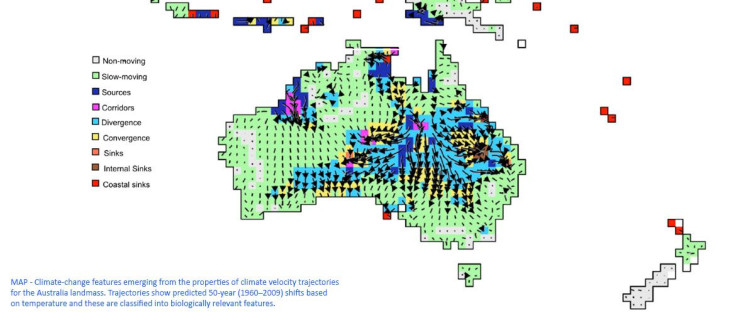New Climate Change Map Reveals Where Species Will Go As Global Temperatures Rise [PHOTOS]

As climate change continues to unfold, some, perhaps many, species will have to find new homes in order to survive.
Innovative maps published as part of a new study in the journal Nature project how certain species may adapt to their changing environments. A team of researchers analyzed 50 years of sea surface and land temperature data to generate two maps based on two different scenarios: One assumes that greenhouse gas emissions are stabilized by 2100 and a second that assumes these emissions continue to increase.
The resulting maps show that climate migration is more complex than simple movement toward the poles.
“As species move to track their ideal temperature conditions, they will sometimes run into what we call a ‘climate sink,’ where the preferred climate simply disappears, leaving species nowhere to go because they are up against a coastline or other barrier,” Carrie Kappel, an NCEAS associate and one of the paper’s authors, said in a statement. “There are a number of those sinks around the world where movement is blocked by a coastline, like in the northern Adriatic Sea or the northern Gulf of Mexico, and there’s no way out because it’s warmer everywhere behind.”

In Australia, where climate change has already forced some species to move to higher elevations, the generated maps show where they will have to move to find their ideal temperature. Pink areas on the map indicate “corridors” that animals and plants might move through to get to better conditions. Blue areas represent areas where temperature change will be at its highest, and orange spots are “sink” areas where species will meet a dead end by hitting a coastline or mountain range.
Researchers predict that as the temperature increases over the coming decades, more and more regions will see species migration.
“Even though the patterns of shifting climate stay the same, the areas of change are increasing in size. We are already seeing changes. Worryingly, in places like the Great Australian Bight, the survival pathways are moving offshore, which is obviously a problem for land-based animals,” research co-author Dr. Elvira Poloczanska, of the CSIRO, told Guardian Australia.
Researchers point to past examples to support their findings.
“From other work, we know that many species have shifted where they live in ways that match the pattern of temperature change over the last 60 years,” Kappel said. “This gives us confidence that we can base conservation planning on what we’ve learned about what’s already happening.”
And while the study can’t be used as the sole resource to plann against the consequences of climate change, it may help conservationists protect endemic species that may need to migrate in the future. Researchers suggest “assisted movement” programs can act as a protective measure.
“In an unprecedented period of climate change, economic development and fast-growing demand on an already pressured planet, we need to act fast to ensure most of the world’s living resources survive that change,” CSIRO researchers in a blog post.
© Copyright IBTimes 2025. All rights reserved.






















